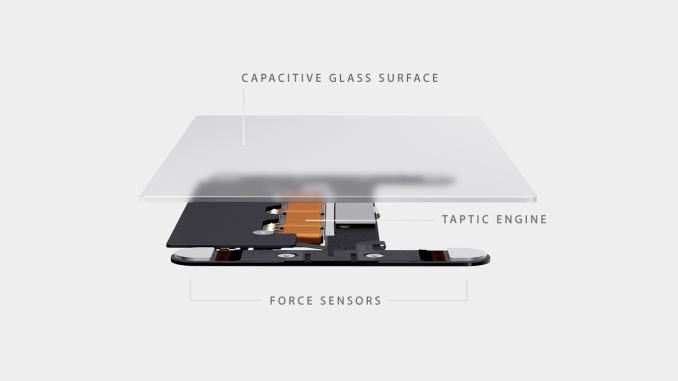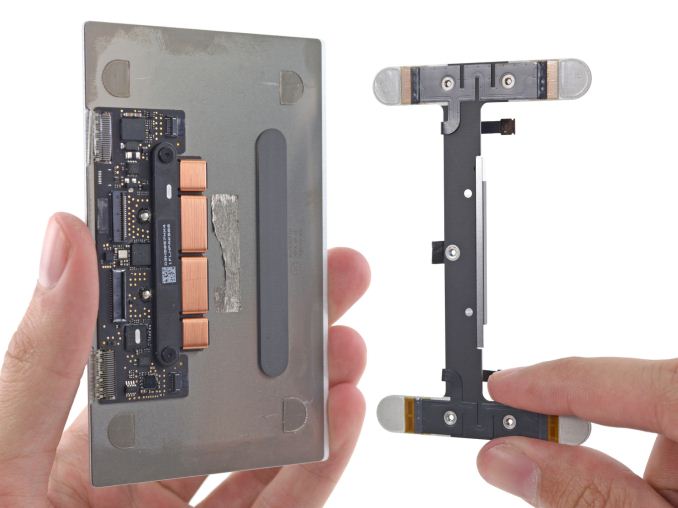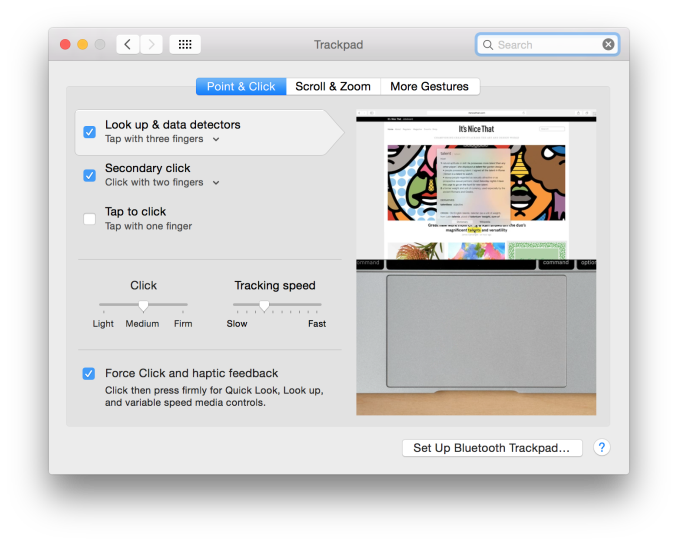The 2015 MacBook Review
by Ryan Smith on April 14, 2015 10:15 AM ESTForce Touch Trackpad
Along with Apple’s changes to their keyboard, the company has also gone in and significantly reworked their trackpad. The new Force Touch Trackpad represents the biggest change to Apple’s trackpad design since the creation of the capacitive, multi-touch pivoting trackpad introduced on the unibody MacBook Pro. In putting together the Force Touch Trackpad, Apple has significantly reworked the internals of the trackpad, creating a trackpad that behaves a lot like their traditional trackpad with some new features, but under the hood relies on some very different mechanisms.
The big change here is that Apple has done away with the traditional pivot and switch mechanism. With pivot and switch, the capacitive trackpad surface would act like a small touchscreen, and underneath it was a switch to register when the trackpad was pressed down. Mechanically the trackpad pivoted from the top (Apple likes to compare it to a diving board), with the trackpad inferring what action to take based on the combination of the capacitive readings and the switch reading. Multi-finger gestures would rely solely on the capacitive layer, primary/secondary clicks would be based on the number of fingers in use when the switch was actuated, etc.
The Force Touch Trackpad on the other hand eliminates the pivot and switch mechanism in favor of a combination of an electromagnet and force/pressure sensors. The pressure sensors essentially replace the physical switch, allowing the trackpad to tell when it has been pressed based on the amount of pressure, and thanks to the pressure sensors it can now tell how hard it has been pressed as opposed to the binary nature of the physical switch. Meanwhile without a physical switch in place to provide the clicking sensation and feedback of pressing down on the touchpad, Apple’s electromagnet – the Taptic Engine – activates to simulate the feeling and noise of pressing a switch.
Update 04/15/2015: iFixit has a great shot of the trackpad's internals, including a good look at just how big the electromagnet/taptic engine really is.
The end result is that the MacBook’s trackpad is among the first wave of devices that ships with Apple’s next generation trackpad and the enhanced capabilities that go with it. Ignoring the pressure sensitivity for a moment (we’ll get back to it), replacing the pivot and switch for an electromagnet works shockingly well. From a touch & feel standpoint the Force Touch Trackpad feels virtually identical to a traditional trackpad, to the point where it’s more than a bit uncanny. In practice you are not actually triggering a switch nor is the trackpad really moving (technically it’s deforming ever so slightly), but it sure feels like you’re working a switch. Apple has clearly done their homework on getting an electromagnet to emulate a switch, to great results. Meanwhile they don’t have the trackpad’s acoustics precisely matching a switch, but the resulting pinball-machine like plunk is close enough to a click that I don’t imagine anyone will mind the difference.
One side benefit of this change is that the trackpad feels the same throughout, and unlike the pivoting trackpad does not require more or less force depending on where you are relative to the pivot point. The variable force required has never been a major problem in my experience, but it is nice to no longer need to worry about where your fingers are relative to the top, and consequently how much force you need to use.
However the bigger deal is that by making the amount of force required to click consistent throughout the entire trackpad, Apple can now use the amount of pressure applied as another input, making the trackpad pressure-sensitive. The underlying pressure sensors and electromagnet are by default programmed to have two levels of feedback – a shallower press is equivalent to a click – and a deeper press brings about the pressure-sensitive “Force Click.” What force clicking does depends on the application, and right now it’s clear that Apple is still experimenting with what they can do with pressure sensitivity. The most obvious uses include line thickness in drawing applications, but the company is also using it for things such as variable speed fast forward and rewinding in QuickTime/iMovie. At times the force click is treated like a 3rd (tertiary) click, and other times the result is based on variable pressure. Since this is a new (and uncommon) feature there’s no global action assigned to the force click – nor does it behave as a middle click on a regular mouse – so what happens is up to the application.
In implementing force click and the Force Touch Trackpad, Apple does offer the ability to control the amount of pressure required and whether force click is active. With force click deactivated the trackpad behaves more or less identical to a traditional trackpad with a single click level. Meanwhile the click pressure setting is interesting, though I’m not entirely convinced it’s all that effective. Short of the tools to actually measure click pressure, I’m not so sure Apple is changing the amount of pressure required to trigger a click so much as they’re changing how hard the electromagnet vibrates. The feedback change is certainly very subtle going from light to firm, and if there is a change in the amount of pressure required then it is certainly equally subtle.
Ultimately whether the Force Touch Trackpad is a major upgrade or not is going to depend on a user’s ability to make use of the force click features. Even turned off, the new trackpad is essentially an improved version of the old trackpad without the minor drawbacks of the pivot mechanism. But with the force click turned on, then it brings new (though not always useful) actions to the trackpad that in turn makes it a bigger upgrade over the old trackpad.
In any case, the MacBook along with the 2015 MacBook Pro 13” are the first wave of devices to implement the new Force Touch Trackpad. Given its expanded capabilities I would expect Apple to eventually replace many (if not all) of their trackpads with this new design. Certainly the 15” MacBook Pro is a likely candidate, as is a future version of the Magic Trackpad. What remains to be seen is whether the next MacBook Air also gets this new trackpad, or if Apple withholds it to keep the products differentiated and to keep the costs of the MacBook Air down.














354 Comments
View All Comments
TEAMSWITCHER - Tuesday, April 14, 2015 - link
I don't think the point is to sell dongles. The latest OS X and iOS update introduced a new feature called iCloud photos. Now, when I take pictures with my iPhone, they are automatically transferred to my Mac using iCloud. The $69 AppleTV (cheaper than the AV dongle) is an AirPlay target. Clearly, Apple is moving deeper into the world of wireless convenience.wiz329 - Tuesday, April 14, 2015 - link
Doubtful. You gotta create that content somewhere!Dorek - Tuesday, April 14, 2015 - link
Yeah, on a PC!smiddlehurstl - Wednesday, April 15, 2015 - link
Riiight... Mac sales accounted for 9% of revenue in the Christmas quarter. Might not sound much but this is Apple so that translates to around 6.7 BILLION dollars, a record for Mac revenue. Apple still pretty much owns the top end of the laptop market and continues to grow its market. And you think they want to kill that market?jabber - Wednesday, April 15, 2015 - link
9% but if the markets approve then the stockprice could well negate that 'loss' in revenue easily. Plus it would mean more resource for the bigger selling products.OSX is a millstone for Apple.
nonoverclock - Tuesday, April 14, 2015 - link
For the battery numbers, is the operating system version consistent? If not, I'm wondering how much a factor the version of OS X is.Ryan Smith - Tuesday, April 14, 2015 - link
The numbers for the older Mac are from our Bench archives, so the answer would be no. But even if we did have the Macs on hand, battery degradation would be a major issue.id4andrei - Tuesday, April 14, 2015 - link
You should have used other Core M notebooks in your battery charts instead of macbooks only. I don't want to think you didn't want to put the macbook's result of 8 hours in a bad light, seeing how the 700$ UX305 manages to reach 11 hours.Kevin G - Tuesday, April 14, 2015 - link
Considering the issues driving the 4K display at 60 Hz, have you tried using a MST hub to get multiple displays functioning? In theory it should support up to three displays and remember to factor in the built-in display here. This would give some indication of how that system would handle MST for a single display.a nonguy - Tuesday, April 14, 2015 - link
From https://support.apple.com/en-us/HT202856The MacBook (Retina, 12-inch, Early 2015) will support these displays and rates using the USB-C Digital AV Multiport Adapter.
* 3840x2160 at 30 Hz refresh rate
* 4096x2160 at 24 Hz refresh rate (mirroring is not supported at this resolution)